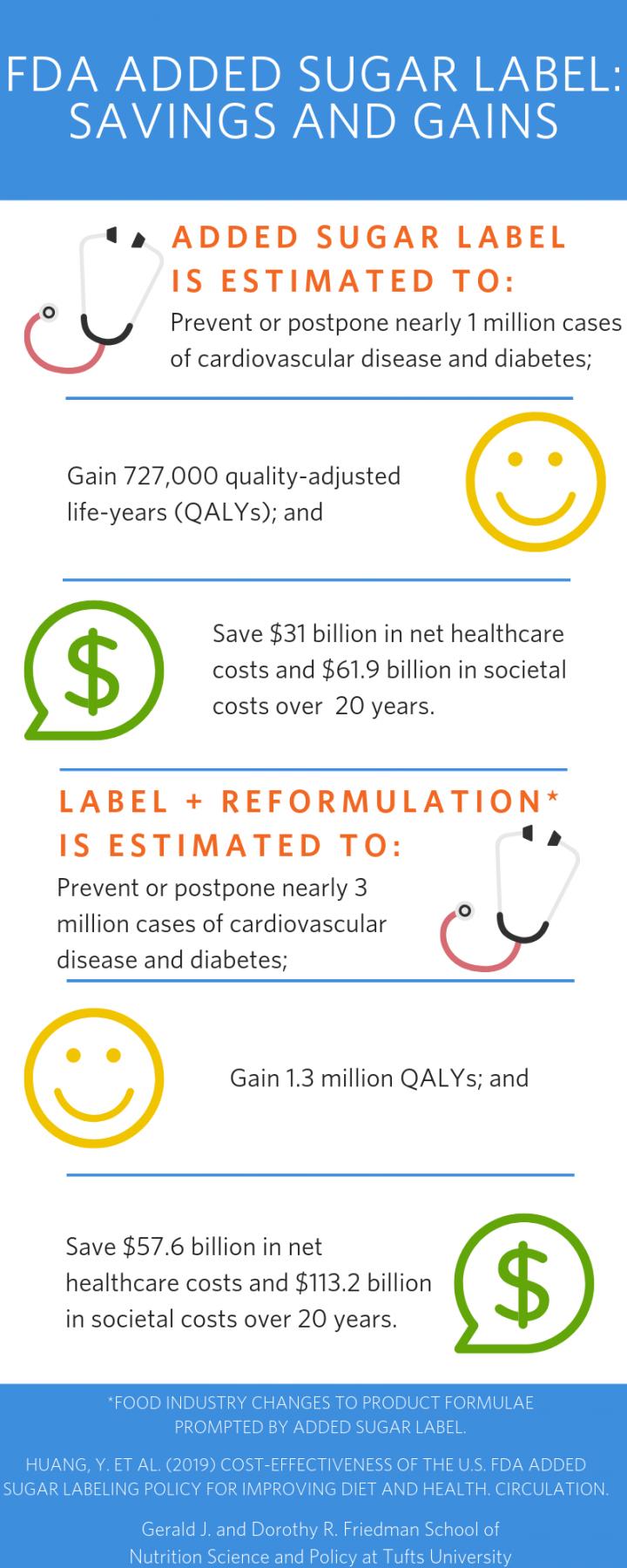Model estimates prevention of nearly 1 million cases of cardiometabolic disease, billions of dollars in savings in first 20 years of label’s use

Credit: Tufts University
BOSTON (April 15, 2019, 5:00 a.m. ET)–The Food and Drug Administration’s (FDA) mandatory added sugar labeling policy for packaged foods and beverages, set to take effect between 2020 and 2021, could be a cost-effective way to generate important health gains and cost-savings for both the healthcare system and society in the U.S., according to a new modeling study led by researchers from the Friedman School of Nutrition Science and Policy at Tufts University and the University of Liverpool. The analysis is the first to estimate the potential health and economic impacts of the new label.
In 2016, the FDA announced several mandatory changes to the Nutrition Facts label in order to provide consumers with enhanced nutritional information. Among the changes was adding the grams and percent Daily Value of added sugar content, which would help consumers limit calories from added sugar in accordance with the recommendations of the 2015-2020 Dietary Guidelines for Americans.
The study, published today in Circulation, estimates that the FDA’s added sugar label could prevent or postpone nearly 1 million cases of cardiometabolic disease, including heart disease, stroke and type 2 diabetes, over a 20-year period. When combined with possible industry reformulations to reduce added sugar content in packaged foods and beverages, the label could prevent or postpone nearly 3 million cases of cardiovascular disease and diabetes over the same time period. Cost-effectiveness of each scenario was evaluated from a healthcare perspective (accounting for policy costs and medical costs) and from a societal perspective (further accounting for informal care costs and lost productivity costs). Both scenarios were estimated to be cost-effective within five years and cost-saving within seven years.
Specifically, the analysis estimates that the added sugar label could:
- Prevent or postpone 354,400 cases of cardiovascular disease and 599,300 cases of diabetes;
- Gain 727,000 quality-adjusted life-years (QALYs); and
- Save $31 billion in net healthcare costs and $61.9 billion in societal costs. Policy costs were estimated to be $1.7 billion.
Taking into consideration possible reformulation by the food industry, the analysis yielded greater corresponding gains, estimating that the new label could:
- Prevent or postpone 708,800 cases of cardiovascular disease and 1.2 million cases of diabetes;
- Gain 1.3 million QALYs; and
- Save $57.6 billion in net healthcare costs and $113.2 billion in societal costs. Policy costs, including industry reformulation costs, were estimated to be $4.3 billion.
“The added sugar label is an important policy step toward reducing consumption of foods and beverages with high added sugar contents, improving health, and lowering healthcare spending,” said Renata Micha, R.D., Ph.D., the study’s co-senior and corresponding author and research associate professor at the Friedman School of Nutrition Science and Policy at Tufts University. “These findings have important implications for individuals, policy makers and the food industry alike. Modest industry reformulation would be a powerful way to maximize potential benefits, highlighting industry’s critical role in being part of the solution.”
While some companies have begun listing added sugar content, the 2018 deadline for compliance has been extended to 2020 for large manufacturers and 2021 for small manufacturers.
“Informing consumers about what is in their sugary drinks, cakes, and sweets will help them decide what they want to eat for their health now and later,” said Martin O’Flaherty, M.D., Ph.D., co-senior author and professor in epidemiology at the University of Liverpool. “Full implementation of the label before 2021 could help maximize health and economic gains.”
The researchers note that Americans consume more than 15 percent of their total calories from added sugars and overconsumption of added sugars is linked to an increased risk of cardiometabolic diseases. These diseases pose large health and economic burdens for the society and the healthcare system. Food labeling could be an effective strategy to support informed consumer choice and reduce added sugar intake, while further stimulating industry reformulation, as supported by recent experience with trans fat labeling in the U.S.
The researchers used a validated microsimulation model (IMPACT) to estimate the potential health impact, costs, and cost-effectiveness of the FDA’s added sugar label based on the two scenarios, which were compared with a “no intervention” baseline scenario over a 20-year timeframe (2018-2037). The model generated a sample representative of the U.S. adult population and utilized data from the two most recent National Health and Nutrition Examination Survey cycles (2011-2014), CDC Wonder, meta-analyses, and other validated sources.
The model evaluated health benefits and cost-savings from cardiometabolic health outcomes; increased healthcare costs from competing diseases could reduce cost-effectiveness, while other health benefits would further contribute to health gains and cost-savings.
###
Co-first authors are Yue Huang, Friedman School, and Chris Kypridemos, University of Liverpool.
The study is part of the Food Policy Review and Intervention Cost-Effectiveness (Food-PRICE) research initiative, a National Institutes of Health-funded collaboration led by researchers at Tufts University working to identify nutrition strategies that can have the greatest impact on improving diet and health in the United States.
Additional authors are Junxiu Liu, Yujin Lee, Parke Wilde, and Dariush Mozaffarian, Friedman School; Jonathan Pearson-Stuttard, University of Liverpool, and Imperial College London; Brendan Collins and Simon Capewell, University of Liverpool; Piotr Bandosz, University of Liverpool, and Medical University of Gdansk; and Laurie Whitsel, American Heart Association.
This study was supported by an award from the National Heart, Lung, and Blood Institute of the National Institutes of Health (R01HL130735). Additional support was provided through a postdoctoral fellowship award from the American Heart Association. For conflicts of interest disclosure, please see the study. The content is solely the responsibility of the authors and does not necessarily represent the official views of the National Institutes of Health or the American Heart Association.
Huang, Y., Kypridemos, C., Liu, J., Lee, Y., Pearson-Stuttard, J., Collins, B., Bandosz, P., Capewell, S., Whitsel, L., Wilde, P., Mozaffarian, D., O’Flaherty, M., and Micha, R. (2019) Cost-effectiveness of the US FDA added sugar labeling policy for improving diet and health. Circulation. doi: 10.1161/CIRCULATIONAHA.118.036751
A television studio located at the Friedman School on Tufts University’s Boston Health Sciences campus is available for live and recorded interviews with faculty and researchers. For more information, please contact Lisa LaPoint at [email protected] or 617-636-3707
About the Friedman School of Nutrition Science and Policy at Tufts University
The Gerald J. and Dorothy R. Friedman School of Nutrition Science and Policy at Tufts University is the only independent school of nutrition in the United States. The school’s five divisions – which focus on questions relating to nutrition and chronic diseases, molecular nutrition, agriculture and sustainability, food security, humanitarian assistance, public health nutrition, and food policy and economics – are renowned for the application of scientific research to national and international policy.
Media Contact
Lisa LaPoint
[email protected]
Related Journal Article
http://dx.




